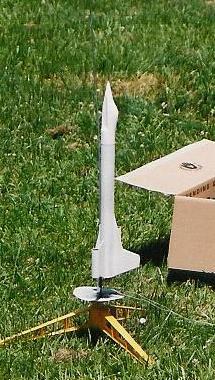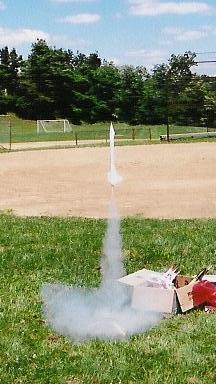Scratch Marauder Original Design / Scratch Built
Scratch - Marauder {Scratch}
Contributed by Bill Eichelberger
| Manufacturer: | Scratch |
 Brief:
Brief:
The Marauder was my re-introduction to scratch building after getting back into
the hobby in early 2001. In my early days in rocketry 20+ years ago I had
enjoyed scratch building to the point that no paper tube in the house was safe
from my “creative” eye. (Luckily no pictures exist of any of these
early creations, although I do have the fins from one of them.) While garbage
picking was my method of procuring materials in 1977 (and served me quite
well,) in 2001 I mistakenly thought that the best way to get back into scratch
building was by buying an Estes Designer’s Special. Unfortunately, the
Designer’s Special that I had always lusted for as a kid and bought as an
adult turned out to be little more than Estes way of getting rid of some of
their more hideous mistakes. One of these mistakes was the brick-like
“nose cone” from the SDI Satellite, one of the least attractive,
albeit most unique looking, rockets ever to disgrace the skies. Another was the
almost equally hideous cockpit style nose cone that had once been part of the
Greyhawk kit as well as several others. It was out of the necessity to use this
cone that the Marauder was born.
Construction:
- 1 - 15" length BT-55
- 2 - 3" lengths BT-20
- 1 - PNC-55? from Estes Greyhawk or AstroSat LSX
- 18" length of 1/4" sewing elastic
- 3/32" basswood for fins
- standard launch lug
- 18" parachute
- 18mm engine mount kit
- snap swivel
 At a loss to come up
with a fin pattern distinctive enough for the monstrous nose cone, I scanned
the JimZ site and found the Intruder in the Model Rocket News plan section.
Since the Intruder was originally planned as a BT-20 rocket, I had to enlarge
everything by 180%. I found a moron-friendly copier that managed this for me,
so it wasn’t a problem. While I liked the Intruder’s original design,
I wasn’t crazy about the chevron-shaped wingtip fins, (especially after
enlarging them,) so I replaced them with the 3" lengths of BT-20. The
futuristic looking fighter that resulted after mating on the nose cone just
goes to show what a great design the original Intruder was.
At a loss to come up
with a fin pattern distinctive enough for the monstrous nose cone, I scanned
the JimZ site and found the Intruder in the Model Rocket News plan section.
Since the Intruder was originally planned as a BT-20 rocket, I had to enlarge
everything by 180%. I found a moron-friendly copier that managed this for me,
so it wasn’t a problem. While I liked the Intruder’s original design,
I wasn’t crazy about the chevron-shaped wingtip fins, (especially after
enlarging them,) so I replaced them with the 3" lengths of BT-20. The
futuristic looking fighter that resulted after mating on the nose cone just
goes to show what a great design the original Intruder was.
As I mentioned earlier, I used basswood in place of balsa when building the fins. This not only allows for an extra measure of sturdiness, but also makes finishing much less of a headache. To further increase the chances that it would survive past one flight I poked holes in the body tubes around each fin with a pin drill after they had been attached, then allowed the Elmer’s White Glue to seep into the holes during the fin fillet process. This makes small glue rivets that are supposed to greatly strengthen the fin to body tube joint. Elmer’s Wood Glue was used in all other areas of construction. I experimented with several different colors before settling on the battleship grey that I had originally planned on. Various military decals from old plastic model kits finished off the construction and from that point, all that was left was to come up with a name. I plucked Marauder from an old Mercury that a neighbor had when I was a kid. It seemed like the perfect name for a rocket. (Turns out that both Estes and Centuri thought so also.)
 Flight:
Flight:
The first flight of the Marauder came at a family launch on Good Friday (known
now as the Good Fly Day Launch — no one else laughed either.) Since I had
so recently gotten restarted in the hobby and didn’t have a lot of
confidence in my scratch building skills, I conservatively chose a B6-4 for the
first flight. I needn’t have worried. The rocket rolled slightly as it
left the pad, arcing gently into the wind and topping out at a respectable
height. Recovery was trouble-free until it touched the ground. Then it almost
became a one flight wonder under the stampeding hooves of the accumulated
nieces and nephews. The field we flew on that day was huge and after the
performance of the rocket on it’s first flight I was kicking myself for
not having loaded it with a C6-5. Flight #2 took place at a local soccer field,
also on a B6-4, but this time because of the small field size. The Marauder
drifted badly on this flight, even with a reefed chute, and managed to badly
damage a fin on a hard landing into a curb. Once the damaged fin was fixed
several weeks later, we returned to the same field on a calm evening for what
would be flight #3. Since it was a calm night at ground level and also because
the Marauder recovered quickly on it’s reefed chute, I decided to go with
the C6-5 that the first two flights seemed to have begged for. The flight was
as impressive as I had expected, but recovery was a different matter entirely.
The extra punch that the C6-5 provided apparently allowed the rocket to get
into the area above the field where there was a breeze. Upon ejection the
rocket began drifting rapidly to the west toward a subdivision that bordered
the field. I knew I was in trouble when the Marauder cleared the tall hill and
taller trees at the edge of the field by 50 feet or more. I jumped into the van
and tried to chase it down, even going so far as to recruit some of my
son’s football teammates to join in the search. All to no avail. I never
saw the original Marauder again and we now call the field B6-4 field for
reasons obvious.
Summary:
Considering how disappointed I had been when I found what was to become the
Marauder nose cone in my Estes Designer’s Special, the fact that I went
and bought an AstroSat LSX just for the nose cone within a few days of the
Marauder’s final flight goes a long way toward demonstrating how impressed
I was with the rocket’s performance. The Marauder that replaced it has
exhibited the same flight characteristics as the original, having been flown
regularly when not being repaired after one of it’s frequent hard
landings. It’s a fairly heavy rocket with an unfortunate taste for asphalt
and concrete, and anything other than a pillow soft landing seems to cause some
sort of serious fin damage. Since it is creeping stealthily up on its first
full year of service and seems to be becoming more obviously brittle in its old
age, I’m beginning to think it might be time to retire #2, or at the very
least, rebuild it. A stouter build with epoxy? D engine power? A Centuri Super
Kit-style dual chute recovery? This could be fun.
 |
 |
Flights
 |
 |